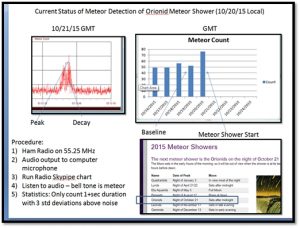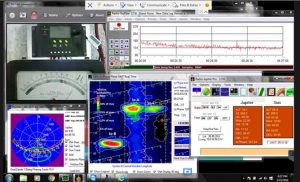Meteor Scatter Observations
Meteor showers happen when Earth’s orbit crosses the orbit of a comet or asteroid. The bits of dust and material remain after the comet or asteroid passes and the resultant meteor shower is a result of these particles entering Earth’s atmosphere.
The meteor leaves an ionized trail of material in the atmosphere that is highly reflective to a radio signal. An available ground based radio signal is the analog video television channel signal at 55.25 MHZ. The U.S. no longer broadcasts this frequency since the country went to digital television. However, it appears that there are a few signals being broadcast from Canada and Mexico.
Station setup:
- Receiver at 55.25 MHZ
- Antenna ( dipole or yagi at this frequency)
- Computer (Windows operating system with microphone or other audi input)
- Software – Radio Skypipe http://www.radiosky.com/skypipeishere.html
- Audio jumper from radio audio out to computer microphone in
Results:
- The atmosphere normally does not reflect the 55.25MHz signal. When the meteor enters the atmosphere, the signal does reflect off the ionization trail and is reflected back toward the ground. The signal sounds like a bell tone when received.
- Using the Radio Skypipe software, the signal spikes in amplitude and then reduces in a “shark Fin” geometry. This is caused by the meteor ionization trail degrading and therefore the reflected signal reduces gradually.

Skypipe will also allow the operator to count the number of meteors during a period of time. The below chart shows the results from last years Leonid meteor shower.

Future observations:
| Shower | Approximate Date | Parent Object |
| Quadrantids | January 3-4 | Asteroid 2003 EH1 |
| Lyrids | April 21-22 | Comet Thatcher |
| Eta Aquariids | May 5-6 | Comet Halley |
| Perseids | August 12-13 | Comet Swift-Tuttle |
| Draconids | October 8-9 | Comet Giacobini-Zinner |
| Orionids | October 21-22 | Comet Halley |
| Taurids | November 5-6 | Comet Encke |
| Leonids | November 17-18 | Comet Tempel-Tuttle |
| Geominids | December 13-14 | Asteroid Phaethon |
| Ursids | December 22-23 | Comet Tuttle |
Contact Dr. Rich Russel for more information on setting up your meteor scatter radio telescope.
